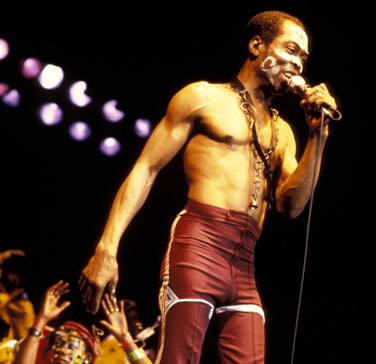
Fela & his “musical” inspiration
By Gregory Lucas-Myers, Charles H. Wright Museum of African American History Hit Broadway, Tony Award-winning musical “Fela!” came through Detroit on February 17, 2012 to March 4, 2012. In conjunction, the Charles H. Wright Museum of African American History welcomed a new exhibit, “Moving to His Own Beat – Fela: The Man, The Movement, The Music.” Museum writer Gregory Lucas-Myers muses on the central theme he sees running through it all.
I had the pleasure of seeing the musical “Fela!” on February 17, its public opening night at Detroit’s Music Hall Center for the Performing Arts. The stage saw no standard, biographical scene-by-scene rundown of Fela’s life, but was instead host to an all-out concert. Many of Fela Kuti’s classic songs were performed live between Fela narrating the sometimes comedic, often tragic story of his life, personal trials, and of post-colonial Nigeria as a whole. Fela, faithfully realized by actor Sahr Ngaujah, enjoyed numerous back-and-forths with the audience, including an impromptu exchange with a man a few rows over from me in the balcony. One scene in particular, wherein Fela goes on a spiritual journey to seek the advice of his deceased mother, was as purely theatric as the play got, filled with all sorts of surreal imagery of crocodiles and light flashes and the actors turned into costumed creatures. Even then, the theme of “inspiration” was the driving factor.
Fela Kuti was born to famed Nigerian female activist Funmilayo Ransome-Kuti, whose own protest activities undoubtedly inspired Fela as he grew and came into his own. The musical itself is set as Fela is giving his last concert in Nigeria, having given up on fighting corruption in his home country following the death of his mother at the hands of the government. Fela regularly turns to speak to a giant, sometimes animated portrait of Funmilayo posted above the stage in his struggle to decide what to do. Her spirit is its own character, stirring him to stay and fight on in Nigeria.
The inspiration is not simply in the mother-son respect. In 1969, Fela came to the U.S. for a time and was inspired by the Black Power movement, especially through an African-American woman named Sandra Smith. The musical style he pioneered, Afrobeat, pulled heavy inspiration from the jazz, funk, West African highlife music, and traditional Yoruba music and chants that came before Fela’s time. And, of course, Fela’s entire mission was to inspire people to action against the oppressive regimes they lived under, simultaneously inspiring them to exist outside strife in their lives and be able to have a good time.
Fela embodied everything good about the arts. He forged his own path, learning from those before him. He emboldened and uplifted those around him. His legacy will continue to inspire generations. Fela is a part of countless films, musical movements, works of art, and even natural wonders that drive us to create. Fela Kuti can add my name to the list of millions that he has inspired with his Afrobeat creation and vivacious fight for justice and equality.
The exhibit “Moving To His Own Beat – Fela: The Man, The Movement, The Music,” created in partnership with Music Hall, is on display at the Charles H. Wright Museum of African American History through April 1. For more information please visit www.TheWright.org.
Recent Content
-
Artsarticle ·
-
Artsarticle ·
-
Artsarticle ·
